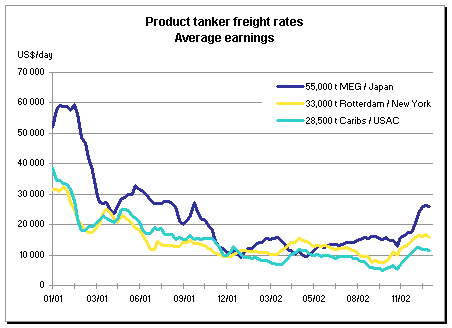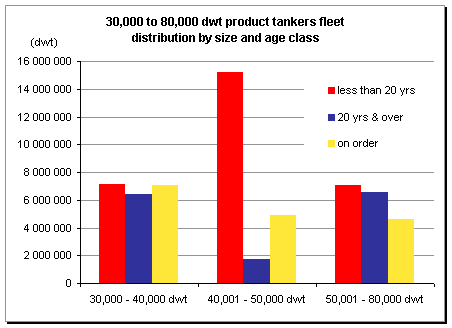
The transport of refined products in 2002
The handysize
The medium range
Availability of modern tonnage
Demand for product tankers
The second-hand market
see also: The crude oil
transport
|
|
With regards to the transport of refined products in
2002, the year ended in a state of euphoria. This unexpected surprise however should not hide the
fact that the year as a whole was rather mediocre: although the market was able to absorb the
numerous deliveries of new ships, the rates obtained both on spot voyages as well as time-charters
during the first 10 months of the year scarcely surpassed the levels obtained at the end of 2001.
The weakness of the world economy affected the demand of refined products, whilst the delivery of
new units were not matched by an equivalent number of vessels being withdrawn from the market.
Nonetheless, it is worth noting:
-
that the Asian zone achieved more activity
than had been foreseen, resulting in a large increase in naphtha imports, which was
particularly favourable to the bigger sizes: LR1 and LR2.
-
that although the market was generally
depressed, it nevertheless remained very volatile, showing that the delivery of 80 new
product carriers (from 30 to 80,000 dwt) was not enough to upset the balance of supply and
demand in tonnage.
For the second year running, daily returns of product
carriers suffered a steady decline.
|
| The 'handysize'
(handy product) from 25,000 to 40,000 dwt |
|
|
Specialising in the Mediterranean-Atlantic zone, this
category was the first to feel the pinch of the weak American demand and the stagnation in Europe:
daily returns dropped continuously from January to October, with the exception of the month of
April, with the low point being achieved in September.
Despite the poor state of the market overall, modern vessels (double-hulled) were always given
priority by charterers.
While average daily returns achieved around $ 11,500 per day, levels being asked by owners for
periods of 1 year rarely dropped below $ 13,500 per day, reflecting the confidence in modern vessels
by charterers. Very few long period charters (2 years or more) were concluded, with the exception of
refinancing operations (bareboat charters).
Owners confidence is based on the evidence of a very volatile market, which is explained by two
principal factors:
This sector of the market is therefore particularly
sensitive to the change in the demand of 'clean' refined products to which the tonnage supply
cannot adjust to quickly, thus being the first to benefit from the upsurge realised at the end of
the year.
|

|
| The 'medium range'
(MR product) from 40,000 to 50,000 dwt |
|
|
This category of the fleet is the most modern and
most numerous. Daily returns suffered the effects of the backlash in the general demand. However
working primarily in the Asian zone, these vessels were on the whole better off than the handysize.
In addition they continued to be sought after for medium term periods.
In the Atlantic zone daily returns followed the same fate as the handysizes, with the average
monthly rates being around $ 12,500 per day.
Despite a thin period between April to May, vessels in the Asian zone were able to benefit from the
good behaviour of the local market and in the absence of competition from the 35 ' 37,000 dwt were
able to perform inter zone voyages. They also were able to enjoy certain long voyages: Middle East
Gulf / Europe and above all Singapore or South Korea ' U.S. West Coast.
Given the relatively satisfactory results on daily returns, owners of modern vessels kept to their
objectives of between $ 13,750 to $ 14,000 per day, pushing charterers to fall back on vessels of 10
to 12 years of age. Notwithstanding several long term periods (3 to 5 years) were made.
|
|
Specialising in the transport of light products
(naphtha / condensate) towards Japan and Korea, these vessels were able to benefit from the strong
Asian demand. They also were frequently fixed for voyages towards Europe and the U.S. West Coast.
Despite the fact that the curve on rates rose from April to October, daily returns rarely surpassed
$ 15,000 per day for LR1s and $ 16,000 per day for LR2s up until the take-off in November. However
the suddenness of the rise in rates, which broke the $25,000 per day barrier within several days
only goes to show the underlying volatility of the market. The ageing of the LR1 fleet and the small
number of new orders of LR2 should not upset the tendency for 2003.
Few period fixtures were concluded with the exception of modern Panamaxes which Enel and BP
chartered at levels of $14,850 and $15,000 for 3 years.
The sudden rise at the end of the year indicates that the delivery of new ships has not upset the
balance in the supply and demand of tonnage, nonetheless this balance could quickly become out of
step'
|
The availability of
modern tonnage, which did not really become
surplus at the end of 2002, could easily change |
|
|
Eighty new units of 30,000 to 80,000 dwt were
delivered in 2002 and up to 2005 some 300 additional vessels should leave the shipyards.
This increase in modern tonnage, even if no new order for delivery prior to 2005 is made, will
result in a rapid rejuvenation of the available fleet since product tankers less than 20 years old
will increase by more than 20 % in 2005 compared to today (over 850 ships of 30 to 80,000 dwt as
compared to 625 in December 2002).
This rejuvenation applies to all categories of the market (see table) but is particularly
significant in the MR range of 40 to 50,000 dwt.
It is increasingly difficult for vessels over 20 years old to find employment with oil companies,
and even first-class traders. However if these older vessels have difficulty in operating in the
fuel oil sector within the Atlantic zone, they can fall back on the East of Suez market and/or find
activity transporting molasses or vegetable oil.
In these circumstances, even though the recovery of the market which is normal during winter and has
been assisted by the 'Prestige' sinking, it is possible that this is only a short-lived reprieve
given that more than 130 new vessels will come onto the market in 2003.
|

|
Demand for product tankers could
increase in the course
of the next few years |
|
|
The growing expansion of American imports from
Russian origin will automatically increase the requirements for product tankers by extending the
number of long voyages and in requiring owners to develop their 'ice-class' tonnage.
In addition, it is probable that given that the existing fleet of double-hulled Aframaxes will not
be sufficient to satisfy the transport needs for fuel oil, vessels of 45,000 dwt and new Panamaxes
will find a secondary market of increasing interest.
Finally, even if European demand remains in the doldrums, the American economy is at last showing
signs of recovery, and this is the major factor in moving freight rates especially as the Venezuelan
crisis might push the U.S. to find alternative supplies from further afield.
If all these factors keep their promise, the year 2003 might prove to be much better than one might
expect given the numerous deliveries scheduled.
However any optimistic forecast should be tempered by the recognition that the improvement in the
world economy remains fragile. An economic crisis in the Far East, a military crisis in Iraq, an
important bankruptcy in Europe, could jeopardise the recovery and the market would then go back into
a slump
|
| Product tankers
second-hand market |
|
|
2002 can be qualified as a low profile year. Hardly
more than 58 ships of 25,000 to 110,000 dwt were sold for further trading including 33 handysize, 17
medium range and 8 long range product tankers. Eighteen ships built in the 70's were sold, against
22 built in the 80's and 18 in the 90's among which 10 were less than 3 years old.
In this size range, 76 ships were delivered in 2002 representing 3.55 million dwt. In the same
period of time, 56 ships were deleted for a total of 2.05 million dwt, but at the end of the year
the orderbook accounted for 329 product tankers for an overall tonnage of 17.2 million dwt, of which
153 for delivery in 2003, 134 in 2004 and around 40 in 2005.
With low freight rates being maintained over a large part of the year, ships values took without any
surprise their way down at least until October, before gaining again some ground by the end of the
year.
A standard 45,000 dwt product tanker built in 1998 that worth around $23 million in January, saw its
value declining to $22 million before recovering a level in the region of $23 million in December.
Again in 2002, we observed a significant number of purely financial deals, where sales are
systematically attached to charters back. The German market was particularly attractive for such
deals.
The 'Prestige' incident and the increased pressure coming from both local and international
authorities, act in the favour of modern ships. The demand for recent units is high on the market
that sustains their values, while older assets struggle to find buyers and at price levels directly
linked to their limited trading capacities.
This will accelerate the phasing-out of the oldest units in the years to come. This renewal trend
will also be accelerated by the huge number of ships currently on order, which will heavily weigh on
the market.
The 'Prestige' incident, a cold Winter, the Venezuelan strike and some signs of growth recovery
in the United-States made the year 2002 ending on a bright note. This must however be tempered by
the possible consequences of a war in Iraq, a massive orderbook and a weakness of some other
economic areas in the world.
|
Shipping and Shipbuilding Markets in 2002
I N D E X
|